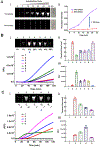Dynamic Aqueous Multiphase Reaction System for One-Pot CRISPR-Cas12a-Based Ultrasensitive and Quantitative Molecular Diagnosis
- PMID: 32390420
- PMCID: PMC7588651
- DOI: 10.1021/acs.analchem.0c01459
Dynamic Aqueous Multiphase Reaction System for One-Pot CRISPR-Cas12a-Based Ultrasensitive and Quantitative Molecular Diagnosis
Abstract
Recently, CRISPR-Cas technology has opened a new era of nucleic acid-based molecular diagnostics. However, current CRISPR-Cas-based nucleic acid biosensing has a lack of the quantitative detection ability and typically requires separate manual operations. Herein, we reported a dynamic aqueous multiphase reaction (DAMR) system for simple, sensitive and quantitative one-pot CRISPR-Cas12a based molecular diagnosis by taking advantage of density difference of sucrose concentration. In the DAMR system, recombinase polymerase amplification (RPA) and CRISPR-Cas12a derived fluorescent detection occurred in spatially separated but connected aqueous phases. Our DAMR system was utilized to quantitatively detect human papillomavirus (HPV) 16 and 18 DNAs with sensitivities of 10 and 100 copies within less than 1 h. Multiplex detection of HPV16/18 in clinical human swab samples were successfully achieved in the DAMR system using 3D-printed microfluidic device. Furthermore, we demonstrated that target DNA in real human plasma samples can be directly amplified and detected in the DAMR system without complicated sample pretreatment. As demonstrated, the DAMR system has shown great potential for development of next-generation point-of-care molecular diagnostics.
Conflict of interest statement
The authors declare no conflict of interest.
Figures





Similar articles
-
Selenium-enhanced recombinase polymerase amplification-CRISPR/Cas12a: A low-noise single-tube assay for human papillomavirus 16 ultrasensitive detection.Int J Biol Macromol. 2025 May;310(Pt 4):143468. doi: 10.1016/j.ijbiomac.2025.143468. Epub 2025 Apr 24. Int J Biol Macromol. 2025. PMID: 40286970
-
Tuning the Dynamic Reaction Balance of CRISPR/Cas12a and RPA in One Pot: A Key to Switch Nucleic Acid Quantification.ACS Sens. 2024 Jul 26;9(7):3511-3519. doi: 10.1021/acssensors.3c02485. Epub 2024 Apr 23. ACS Sens. 2024. PMID: 38651662
-
Dithiothreitol Facilitates LbCas12a with Expanded PAM Preference for Ultrasensitive Nucleic Acid Detection.Anal Chem. 2025 Mar 25;97(11):6286-6294. doi: 10.1021/acs.analchem.5c00280. Epub 2025 Mar 15. Anal Chem. 2025. PMID: 40088462
-
CRISPR-Cas12a System for Biosensing and Gene Regulation.Chem Asian J. 2021 Apr 19;16(8):857-867. doi: 10.1002/asia.202100043. Epub 2021 Mar 18. Chem Asian J. 2021. PMID: 33638271 Review.
-
M-CDC: Magnetic pull-down-assisted colorimetric method based on the CRISPR/Cas12a system.Methods. 2022 Jul;203:259-267. doi: 10.1016/j.ymeth.2021.11.009. Epub 2021 Nov 20. Methods. 2022. PMID: 34813932 Review.
Cited by
-
Powerful CRISPR-Based Biosensing Techniques and Their Integration With Microfluidic Platforms.Front Bioeng Biotechnol. 2022 Feb 23;10:851712. doi: 10.3389/fbioe.2022.851712. eCollection 2022. Front Bioeng Biotechnol. 2022. PMID: 35284406 Free PMC article. Review.
-
CRISPR Assays for Disease Diagnosis: Progress to and Barriers Remaining for Clinical Applications.Adv Sci (Weinh). 2023 Jul;10(20):e2301697. doi: 10.1002/advs.202301697. Epub 2023 May 10. Adv Sci (Weinh). 2023. PMID: 37162202 Free PMC article. Review.
-
Detection of monkeypox virus based on a convenient and sensitive single-step RPA-CRISPR/Cas12a strategy.RSC Adv. 2024 May 7;14(21):14775-14783. doi: 10.1039/d4ra02049a. eCollection 2024 May 2. RSC Adv. 2024. PMID: 38716102 Free PMC article.
-
CRISPR gel: A one-pot biosensing platform for rapid and sensitive detection of HIV viral RNA.Anal Chim Acta. 2023 Jun 29;1262:341258. doi: 10.1016/j.aca.2023.341258. Epub 2023 Apr 24. Anal Chim Acta. 2023. PMID: 37179057 Free PMC article.
-
CRISPR-powered quantitative keyword search engine in DNA data storage.Nat Commun. 2024 Mar 15;15(1):2376. doi: 10.1038/s41467-024-46767-x. Nat Commun. 2024. PMID: 38491032 Free PMC article.
References
-
- Du Y; Dong S Nucleic acid biosensors: recent advances and perspectives. Anal Chem. 2016, 89 (1), 189–215. - PubMed
-
- Li Y; Li S; Wang J; Liu G CRISPR/Cas systems towards next-generation biosensing. Trends Biotechnol. 2019. 37(7), 730–743. - PubMed
-
- Einspanier R; Plath A Detecting mRNA by use of the ribonuclease protection assay (RPA) In Molecular Biomethods Handbook; Springer: 1998; pp 51–57.
Publication types
MeSH terms
Substances
Grants and funding
LinkOut - more resources
Full Text Sources
Other Literature Sources
Research Materials

